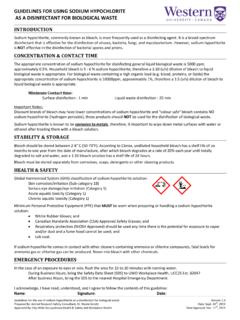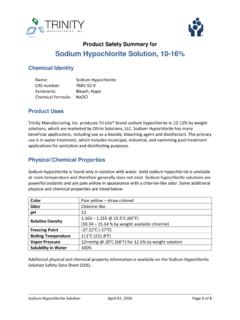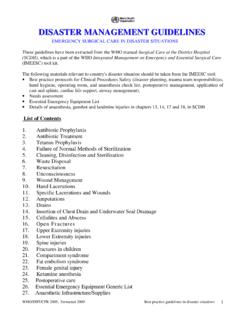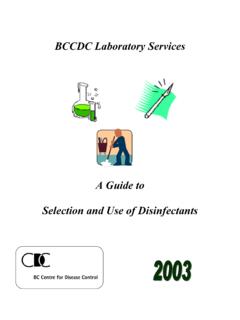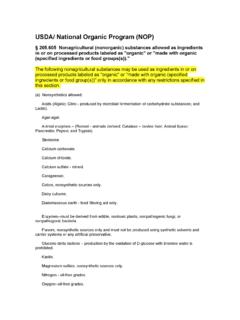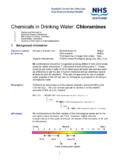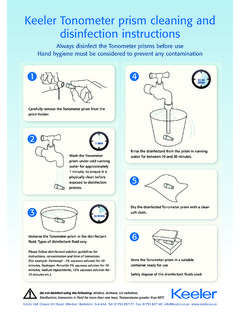Transcription of Disinfection Session Objectives - WHO
1 WHO SEMINAR PACK FOR DRINKING-WATER QUALITYD isinfectionSession Objectives To introduce the principal disinfectants that may be used and highlight key advantages and disadvantages of each To emphasise the use of chlorination for routine Disinfection . To describe the process of chlorination and discuss the concepts of breakpoint chlorination, chlorine demand and outline basic chlorine chemistry. To discuss the types of chlorine available and how these may be used for routine water supplies should be disinfected. This is aimed both at inactivating remaining bacteria before distribution and providing a residual disinfectant to inactivate bacteria introduced by any subsequent ingress of contaminated water during storage or distribution.
2 At present, the principal disinfectant used worldwide is chlorine, although alternatives are being increasingly investigated and process such as ozonation are becoming more common. Chlorine is generally the disinfectant of choice as it is reasonably efficient, cheap and easy to handle. In all but the smallest water treatment plants, chlorine is added to water as either in aqueous solution (calcium hypochlorite or sodium hypochlorite) or chlorine gas. Smaller supplies may use tablets of hypochlorite. Other disinfectants include ozone, ultraviolet light and iodine. These all have disadvantages. UV is not a particularly effective disinfectant and it is difficult to expose water for sufficient time for Disinfection to be effective.
3 Neither ozone or UV provide a residual disinfectant and therefore offer no protection against recontamination in distribution. To overcome this, in some water supplies booster ozonation stations are set up along the distribution network. Both iodine and ozone are carcinogenic. There are also significant health and safety concerns, for operators, regarding the generation and application of ozone and chlorine (especially in the gaseous form). Iodine can also lead to thyroid problems with pregnant women and is generally more toxic than chlorine. Selection of disinfectantUnder most circumstances, overwhelming factors will dictate selection of Disinfection method.
4 The most common major factors are: availability, cost of disinfectant, logistics (especially transport costs), and cost/availability of equipment. Under the majority of circumstances chlorine in one of its forms has been found to be the disinfectant of choice. The choice of which form of chlorine will again largely be determined by availability, cost and transport. ChlorineChlorine is an effective disinfectant where water is not turbid (cloudy) and the pH of the water to be treated is not alkaline, for instance not above pH However, most natural waters have a pH below and thus Disinfection is rarely compromised by pH. Chlorine chemistryChlorine, whether in the form of pure chlorine gas from a cylinder, sodium hypochlorite or calcium hypochlorite in any of its presentations, dissolves in water to form hypochlorous and hydrochloric acids.
5 Chlorine dioxide, however, does not dissolve in water. The reaction of chlorine in water follows the reaction shown below: WHO SEMINAR PACK FOR DRINKING-WATER QUALITY 2 Cl2 + H20 HOCl + HCl Hydrochloric acid dissociates in turn to form hydrogen and chloride ions HCl H+ + Cl-Hypochlorous acid however dissociates only partially H0Cl H+ + OCl-It is undissociated hypochlorous acid which acts as a disinfectant. The equilibrium between undissociated hypochlorous acid, hydrogen ions and hypochlorite ions depends on pH. At high pH (alkaline conditions, pH greater than 8), the dissociated forms predominate and at low pH (acidic conditions) undissociated hypochlorous acid predominates.
6 For this reason Disinfection with chlorine is more efficient at lower pH values and a pH of less than 8 is recommended for Disinfection . Pure chlorine gas from a cylinder tends to decrease the pH of the water slightly; hypochlorite tends to increase water pH a little. Formation of combined chlorine is due to a sequence of reactions. Hydrogen in ammonia is progressively replaced by chlorine as follows: NH3 NHCl NHCl2 NCl3ammonia monochloramine dichloramine nitrogen trichloride Where it is desired to produce monochloramine as a more stable, but less efficient disinfectant, the two chemicals may be dosed in appropriate proportions.
7 NH3 + Cl2 = NH2Cl + HCl If a large chlorine dose is applied (relative to ammonia), as is practised in breakpoint chlorination, then nitrogen is formed. 2NH2Cl + Cl2 N2 + 4 HCl Chlorine demand The total amount of chlorine which will react with both compounds like iron and manganese and with organics and ammonia is referred to as the chlorine demand. The chlorine demand of different waters can vary widely. Chlorine demand is the difference between the amount of chlorine added to the water (the chlorine dose) and the total chlorine detectable in the water. The chlorine demand for some waters, for instance some river waters, can increase dramatically, particularly after heavy rain.
8 4: TECHNICAL ASPECTS ( Disinfection ) 3 Breakpoint chlorination The type of chlorine dosing normally applied to piped water supply systems is referred to as breakpoint chlorination. Sufficient chlorine is added to satisfy all of the chlorine demand and then sufficient extra chlorine is added for the purposes of Disinfection . Figure 1 shows the breakpoint chlorination curve. It indicates the effect of adding more chlorine to water which contains an initial ammonia nitrogen content of 1mg/l. Figure 1. Breakpoint chlorination. Diagram taken from Tebbutt , 1992 The initial rise in residual is predominantly monochloramine (combined chlorine residual).
9 The subsequent fall with further addition of chlorine is due to the decomposition of monochloramine to form nitrogen (the chlorine detected in this phase is also combined residual). Finally the oxidation of ammonia is complete and any additional chlorine will cause an equal increase in the free chlorine residual. Contact timeDisinfection with chlorine is not instantaneous. Time is required in order that any pathogens present in the water are inactivated. The time taken for different types of microbes to be killed varies widely. In general, amoebic cysts are very resistant and require most exposure. Bacteria, including free-living Vibriocholerae are rapidly inactivated by free chlorine under normal conditions.
10 For example, a chlorine residual of 1mg/l after 30 minutes will kill schistosomiasis cercariae, while 2mg/l after 30 minutes may be required to kill amoebic cysts. Thus it is important to ensure that adequate contact time is available before water enters a distribution system or is collected for use. WHO SEMINAR PACK FOR DRINKING-WATER QUALITY 4 Contact time in piped supplies is normally assured by passing the water, after addition of chlorine, into a tank from which it is then abstracted. In small community supplies this is often the storage reservoir (storage tank). In larger systems purpose-built tanks with baffles may be used.










